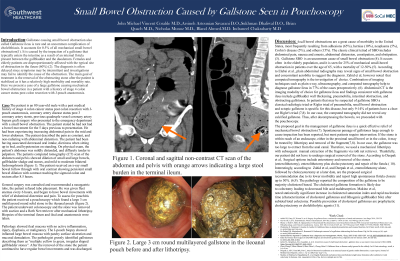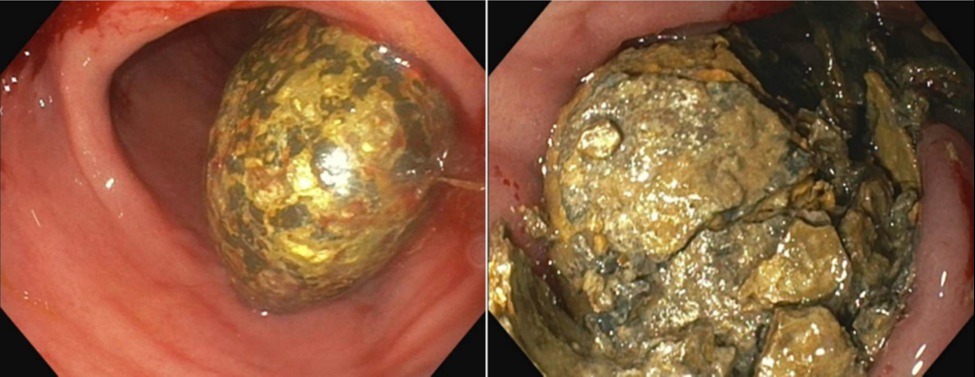Monday Poster Session
Category: Small Intestine
P2709 - Small Bowel Obstruction Caused by Gallstone Seen in Pouchoscopy
Monday, October 23, 2023
10:30 AM - 4:15 PM PT
Location: Exhibit Hall

Has Audio
.jpg)
John Michael Vincent Coralde, MD
UHS SoCal MEC
Temecula, CA
Presenting Author(s)
John Michael Vincent Coralde, MD1, Arsineh Artounian Savarani, DO2, Sukhman Dhaliwal, DO1, Brian Quach, MD1, Nicholas Munoz, MD1, Bland ahmed, MD1, Indraneel Chakrabarty, MD, MA1
1UHS SoCal MEC, Temecula, CA; 2UHS SoCal MED, Temecula, CA
Introduction: Gallstone causing small bowel obstruction is an uncommon complication of cholelithiasis. It accounts for 0.5% of all mechanical small bowel obstructions. Females and elderly patients are disproportionately affected b the typical site of obstruction in the ileum (60%). The diagnosis is often delayed since symptoms may be intermittent and investigations may fail to identify the cause of the obstruction. Here we present a case of a large gallstone causing mechanical bowel obstruction in a patient with a history of stage 4 colon cancer status post colon resection with J-pouch anastomosis.
Case Description/Methods: 80-year-old male with a past medical history of stage 4 colon cancer status post colon resection with J-pouch anastomosis who presented to the emergency department with a small bowel obstruction. The patient's computed tomography scan of the abdomen and pelvis reported "dilation of small and large bowels". The patient underwent a pouchoscopy and the stone was removed with suction and a Roth Net retriever after mechanical lithotripsy. The pathologist grossly identified gallstones describing them as “multiple yellow to green, irregularly shaped gallbladder stones”. After the removal of the stone, the patient continued to have regular bowel movements and was discharged.
Discussion: Small bowel obstructions are a great cause of morbidity in the United States, most frequently resulting from adhesions (65%), hernias (10%), neoplasms (5%), Crohn’s disease (5%), and others (15%). The classic clinical tetrad of SBO includes abdominal pain, nausea and emesis, abdominal distension, constipation, and obstipation. Gallstone SBO is an uncommon cause of small bowel obstruction (4). It occurs often in the elderly population, and it is seen for 25% of mechanical small-bowel obstructions in patients over the age of 65, with a mortality of 12-50%.
The proposed goal in the management of gallstone ileus is a quick effective relief of mechanical bowel obstruction. Spontaneous passage of gallstones large enough to cause impaction has been reported, but most patients require intervention. If the stone is within reach of an endoscope, either in the proximal small bowel or in the colon, it may be treated by lithotripsy and removal of the fragment. In our case, the gallstone was too large to extract from the anal canal. Therefore, we used mechanical lithotripsy with subsequent manual extraction of the fragments via Roth net retriever.

Disclosures:
John Michael Vincent Coralde, MD1, Arsineh Artounian Savarani, DO2, Sukhman Dhaliwal, DO1, Brian Quach, MD1, Nicholas Munoz, MD1, Bland ahmed, MD1, Indraneel Chakrabarty, MD, MA1. P2709 - Small Bowel Obstruction Caused by Gallstone Seen in Pouchoscopy, ACG 2023 Annual Scientific Meeting Abstracts. Vancouver, BC, Canada: American College of Gastroenterology.
1UHS SoCal MEC, Temecula, CA; 2UHS SoCal MED, Temecula, CA
Introduction: Gallstone causing small bowel obstruction is an uncommon complication of cholelithiasis. It accounts for 0.5% of all mechanical small bowel obstructions. Females and elderly patients are disproportionately affected b the typical site of obstruction in the ileum (60%). The diagnosis is often delayed since symptoms may be intermittent and investigations may fail to identify the cause of the obstruction. Here we present a case of a large gallstone causing mechanical bowel obstruction in a patient with a history of stage 4 colon cancer status post colon resection with J-pouch anastomosis.
Case Description/Methods: 80-year-old male with a past medical history of stage 4 colon cancer status post colon resection with J-pouch anastomosis who presented to the emergency department with a small bowel obstruction. The patient's computed tomography scan of the abdomen and pelvis reported "dilation of small and large bowels". The patient underwent a pouchoscopy and the stone was removed with suction and a Roth Net retriever after mechanical lithotripsy. The pathologist grossly identified gallstones describing them as “multiple yellow to green, irregularly shaped gallbladder stones”. After the removal of the stone, the patient continued to have regular bowel movements and was discharged.
Discussion: Small bowel obstructions are a great cause of morbidity in the United States, most frequently resulting from adhesions (65%), hernias (10%), neoplasms (5%), Crohn’s disease (5%), and others (15%). The classic clinical tetrad of SBO includes abdominal pain, nausea and emesis, abdominal distension, constipation, and obstipation. Gallstone SBO is an uncommon cause of small bowel obstruction (4). It occurs often in the elderly population, and it is seen for 25% of mechanical small-bowel obstructions in patients over the age of 65, with a mortality of 12-50%.
The proposed goal in the management of gallstone ileus is a quick effective relief of mechanical bowel obstruction. Spontaneous passage of gallstones large enough to cause impaction has been reported, but most patients require intervention. If the stone is within reach of an endoscope, either in the proximal small bowel or in the colon, it may be treated by lithotripsy and removal of the fragment. In our case, the gallstone was too large to extract from the anal canal. Therefore, we used mechanical lithotripsy with subsequent manual extraction of the fragments via Roth net retriever.

Figure: Multilayered Gallstone seen during pouchoscopy
Disclosures:
John Michael Vincent Coralde indicated no relevant financial relationships.
Arsineh Artounian Savarani indicated no relevant financial relationships.
Sukhman Dhaliwal indicated no relevant financial relationships.
Brian Quach indicated no relevant financial relationships.
Nicholas Munoz indicated no relevant financial relationships.
Bland ahmed indicated no relevant financial relationships.
Indraneel Chakrabarty indicated no relevant financial relationships.
John Michael Vincent Coralde, MD1, Arsineh Artounian Savarani, DO2, Sukhman Dhaliwal, DO1, Brian Quach, MD1, Nicholas Munoz, MD1, Bland ahmed, MD1, Indraneel Chakrabarty, MD, MA1. P2709 - Small Bowel Obstruction Caused by Gallstone Seen in Pouchoscopy, ACG 2023 Annual Scientific Meeting Abstracts. Vancouver, BC, Canada: American College of Gastroenterology.
